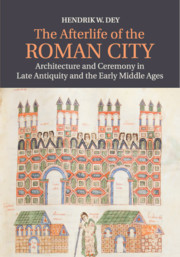Description
The Afterlife of the Roman City
Architecture and Ceremony in Late Antiquity and the Early Middle Ages
Author: Dey Hendrik W.
This book offers a new perspective on the evolution of cities across the Roman Empire in late antiquity and the early Middle Ages.
Language: EnglishApproximative price 34.17 €
In Print (Delivery period: 14 days).
Add to cart
The Afterlife of the Roman City
Publication date: 09-2018
Support: Print on demand
Publication date: 09-2018
Support: Print on demand
Approximative price 116.54 €
In Print (Delivery period: 14 days).
Add to cart
The Afterlife of the Roman City
Publication date: 11-2014
296 p. · 18.4x26 cm · Hardback
Publication date: 11-2014
296 p. · 18.4x26 cm · Hardback
Description
/li>Contents
/li>Biography
/li>
This book offers a new and surprising perspective on the evolution of cities across the Roman Empire in late antiquity and the early Middle Ages (third to ninth centuries AD). It suggests that the tenacious persistence of leading cities across most of the Roman world is due, far more than previously thought, to the persistent inclination of kings, emperors, caliphs, bishops, and their leading subordinates to manifest the glory of their offices on an urban stage, before crowds of city dwellers. Long after the dissolution of the Roman Empire in the fifth century, these communal leaders continued to maintain and embellish monumental architectural corridors established in late antiquity, the narrow but grandiose urban itineraries, essentially processional ways, in which their parades and solemn public appearances consistently unfolded. Hendrik W. Dey's approach selectively integrates urban topography with the actors who unceasingly strove to animate it for many centuries.
1. Introduction: urban living and the 'fall' of the Roman Empire; 2. New urban forms for a new empire: the third century and the genesis of the late antique city; 3. Ceremonial armatures: porticated streets and their architectural appendages; 4. 'Dark ages' and the afterlife of the classical city; 5. Postscript: architecture, ceremony, and monastic cities in Carolingian Francia.
Hendrik W. Dey is Associate Professor in the Department of Art and Art History at Hunter College, City University of New York. Previously he held a two-year Rome Prize fellowship at the American Academy in Rome and an Andrew W. Mellon postdoctoral fellowship at the Center for Advanced Study in the Visual Arts of the National Gallery in Washington, DC. He is the author of The Aurelian Wall and the Refashioning of Imperial Rome, AD 271–855 (Cambridge, 2011) and the co-editor, with Elizabeth Fentress, of Western Monasticism ante litteram: The Spaces of Monastic Observance in Late Antiquity and the Early Middle Ages (2011). He has written articles and book chapters for the Journal of Roman Archaeology, the Journal of Late Antiquity, Early Medieval Europe, Antiquité Tardive, The Cambridge History of Western Monasticism, Reallexikon für Antike und Christentum, and Storia dell'architettura in Italia da Costantino a Carlo Magno, among others.
© 2024 LAVOISIER S.A.S.


